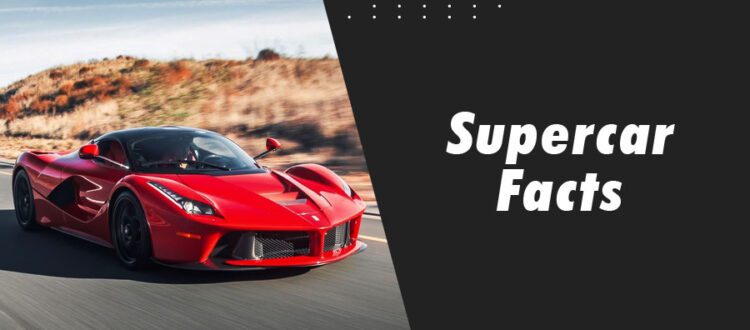Supercar Facts
Starting with a fun fact – the term “supercar” was first used in the 1920s to describe cars that were more powerful and faster than regular cars. Supercars are engineered for the most outstanding performance, pushing the limits of speed and aerodynamics.
Supercars often feature cutting-edge engineering, luxurious design, and premium materials. But what makes these cars that fascinating? We are here to help you explore the thrilling journey of supercar facts through time, and witness the fusion of art and engineering in the world of automotive excellence.
Whether you are looking to show off your knowledge about supercars or you are simply interested in learning more about these powerful and luxurious vehicles, we have highlighted some seriously interesting facts.
Fascinating Facts about Supercars
Join us on an exciting journey through the world of supercars, also known as exotic cars, and discover interesting supercar facts. Once you read about the freedom and splendor these cars offer, your minivan won’t feel the same.
Top speed
- The Bugatti Veyron Super Sport was once the fastest production car in the world, reaching speeds of up to 267 mph (431 km/h). However, it was later surpassed by the Bugatti Chiron, which is electronically limited to a top speed of 261 mph (420 km/h).
- The Koenigsegg Jesko, manufactured by a Swedish car manufacturer, claims to have a potential top speed of 300 mph (483 km/h), which makes it one of the fastest cars in the world.
- The Hennessey Venom F5, created by Hennessey Performance Engineering, aims to achieve a top speed of 311 mph (500 km/h), setting an ambitious goal in the supercar realm.
- The Bugatti Chiron, an evolution of the Veyron, is electronically limited to 261 mph (420 km/h) for road use. However, it is speculated that the Chiron could potentially surpass this speed.
- The Rimac C_Two is an electric hypercar that boasts a top speed of 258 mph (415 km/h), proving the incredible performance capabilities of electric vehicles in the supercar category.
Acceleration and braking
- The Tesla Model S Plaid is not a traditional supercar. It can accelerate from 0 to 60 mph in under 2 seconds, making it one of the fastest production cars in terms of acceleration.
- Supercars like the McLaren P1 take performance to the next level with their advanced hybrid systems. They seamlessly combine electric motors with powerful internal combustion engines. This dynamic pairing delivers instant acceleration, giving drivers an unmatched driving experience.
Supercars use high-performance braking systems made of carbon-ceramic materials to ensure exceptional stopping power.
Unique design elements
- Lamborghini’s iconic scissor doors, featured in models like the Aventador, add a stylish and distinct touch to their designs.
- The Koenigsegg Jesko boasts a ground-breaking Light Speed Transmission (LST), allowing for lightning-fast gear shifts.
- The Rimac C_Two uses facial recognition technology to identify the driver and customize settings for a personalized driving experience.
Price range
Supercars are available at a wide range of prices. They are starting from relatively “affordable” options like the Porsche 911 GT3 to ultra-exclusive hypercars like the Bugatti La Voiture Noire. The latter was sold for approximately $18.68 million, making it one of the most expensive cars ever sold.
Popularity and appeal
Supercars crafted by manufacturers such as Ferrari, Lamborghini, and McLaren enjoy a massive fan following worldwide. These cars frequently feature in movies, music videos, and video games, which adds to their widespread appeal. Limited production runs and exclusive features make supercars highly sought after among collectors, leading to a rise in their popularity and value over time.
Evolution of Supercars over Time
Over the years, the technology and design of supercars have undergone significant changes. They were famous for their powerful engines and lightweight bodies. However, with advancements in turbocharging, aerodynamics, and electronic systems, the performance and handling of these cars have significantly improved. Classic models like the Lamborghini Miura were known for their power and iconic designs.
Supercars today are pushing the boundaries of speed and precision with advanced aerodynamics, turbocharged engines, and electronic aids. There’s also a focus on safety, interior comfort, and sustainability through hybrid and electric powertrains. It’s exciting to see the continuous pursuit of innovation that is redefining the supercar industry.
Future of Supercars
The future of supercars is set to be revolutionized by electric and hybrid technologies. Electric powertrains provide instant torque and produce zero emissions, which is definitely changing the performance standards. Hybrid models balance efficiency and speed, providing the best of both worlds.
Sustainability, connectivity, and autonomous features will be the driving forces behind future developments, ensuring that supercars remain at the cutting edge while being environmentally conscious.
Conclusion
The evolution of supercars has been a fascinating, crazy journey characterized by a remarkable transformation from the raw power of classic models to the cutting-edge performance of modern masterpieces.
These high-performance vehicles have consistently pushed the boundaries of automotive engineering and captured the imagination of car enthusiasts from every generation.
Exploring the intriguing supercar facts and stories behind these cars, one can’t help but feel awe-inspired by the relentless pursuit of excellence and innovation that defines this automotive realm. Each model, with its unique blend of power, speed, and design, has left an indelible mark on the hearts of car enthusiasts, creating a legacy that continues to evolve with time.
Every supercar offers a unique and exhilarating adventure on the road. The question is, which one would provide the most thrilling driving experience?






